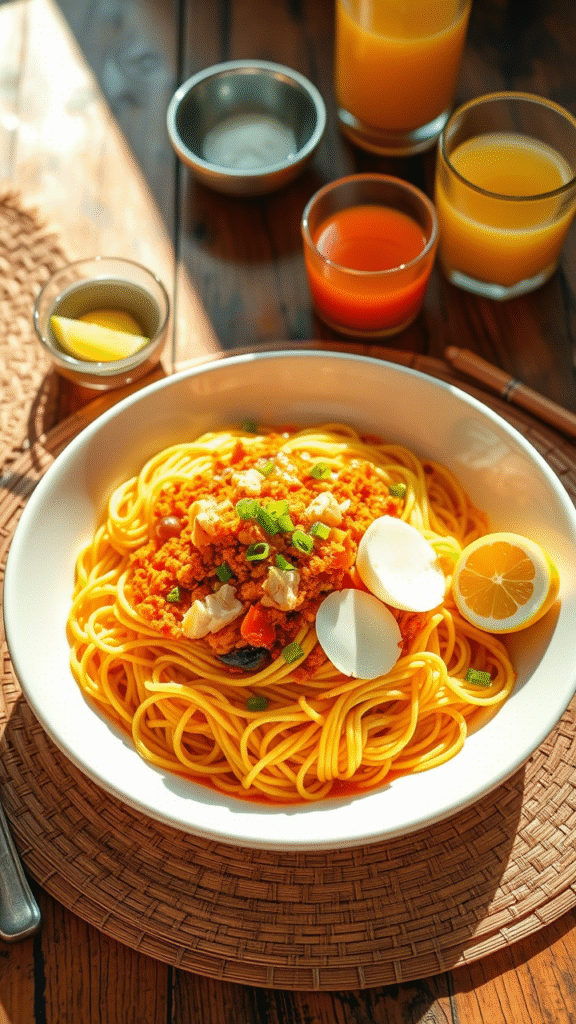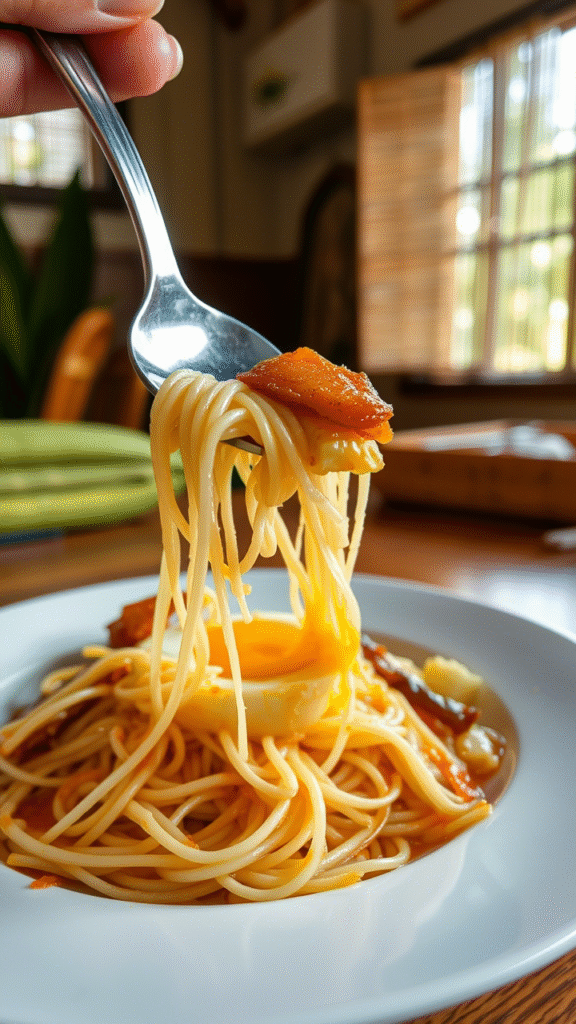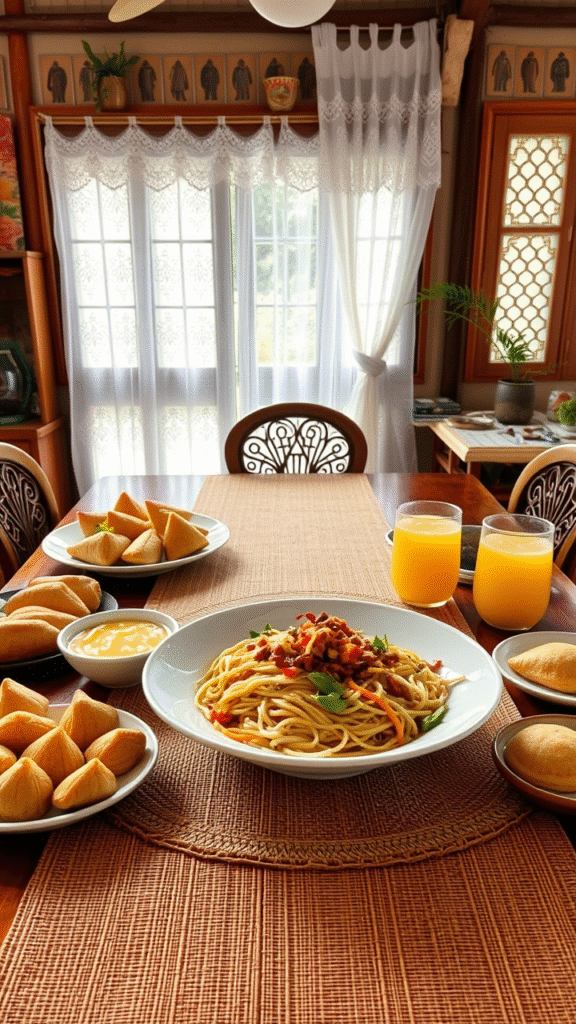When I first learned how to make Pancit Palabok, I ruined the sauce three times. Too thick, too bland, too gloopy. My mentor, a wiry grandmother from Malabon with hands that moved like poetry, just chuckled and said, “A good palabok doesn’t beg for flavor. It shows up dressed for the party.” That line’s stuck with me ever since.
So here we are. Pancit Palabok—a Filipino noodle dish that doesn’t whisper flavor. It shouts. It’s loud. Orange-hued shrimp sauce clinging to chewy rice noodles, topped with a chaos of textures—crunchy chicharrón, slippery boiled egg, salty smoked fish, and a last hit of calamansi so bright it cuts right through. It’s not quiet food. It’s food that demands your full, joyful attention.
But what makes it special—really special—is the story it tells. This dish is heritage, colonial layering, and unapologetic umami all tangled into one plate. And for cooks, especially pros, it’s a dish that rewards precision and boldness in equal measure. Let’s break it down.
What Is Pancit Palabok?

Pancit Palabok is a classic Filipino noodle dish known for its vivid orange shrimp-flavored sauce and decadent toppings. Traditionally served during fiestas and birthdays, it’s a dish of celebration and communal joy. The word “palabok” refers to the saucy style, and it’s one of many types of pancit, the catch-all term for noodle dishes in the Philippines—each with their own identity.
The sauce is built on shrimp stock thickened with rice flour or cornstarch, and it owes its color to annatto (achuete) seeds. It’s not tomato-based, though you’d be forgiven for thinking that at first glance. Garnishes are where the artistry comes in: crumbled pork cracklings (chicharrón), sliced hard-boiled eggs, flaked tinapa (smoked fish), scallions, and sometimes ground pork or shrimp. Squeeze of calamansi on top? Non-negotiable.
Ingredients & Substitutions
Here’s what you’ll need, and some pro notes on getting it just right.
For the Sauce:
- 2 cups shrimp stock (made from shells and heads, don’t skip this)
- 2 tbsp annatto seeds (or 1 tbsp annatto powder)
- 1/4 cup cornstarch (or rice flour for a silkier mouthfeel)
- 2 tbsp fish sauce (use patis, not Thai nam pla—it matters)
- 3 cloves garlic, minced
- 1 small onion, finely chopped
- Salt and pepper to taste
For the Noodles:
- 500g bihon (rice noodles, medium thickness)
- Sub: Soba for an earthy twist, or even vermicelli in a pinch, but you lose the bite.
Toppings:
- 1/2 cup tinapa flakes (smoked bangus is ideal, but mackerel can sub)
- 1/2 cup ground pork, sautéed (optional)
- 3 hard-boiled eggs, sliced
- 1/2 cup chicharrón, crushed
- 2 tbsp toasted garlic
- Sliced scallions
- Calamansi halves (or lemon wedges with a tiny pinch of sugar—trust me)
Ingredient Notes:
Fresh shrimp heads make the stock. It’s the difference between a dish that sings and one that drones. If you’re stuck with frozen shrimp, sauté the heads and shells in a bit of oil before boiling—coaxes out extra flavor.
Use annatto oil, not just powder, if you can. Infuse it in warm oil to bring out color and aroma. And avoid skimping on the garlic—it builds the flavor base and sweetens the whole dish if cooked right.
Step-by-Step Instructions

1. Make the Shrimp Stock
Toss shrimp shells and heads into a pot. Add 3 cups water, bring to a boil, then simmer for 30 mins. Strain and reduce to 2 cups. This ain’t quick, but don’t rush it. If the kitchen doesn’t smell like low tide at this point, something’s off.
2. Infuse the Annatto
Warm 2 tbsp oil, add annatto seeds. Let it sizzle gently for 2-3 minutes. Color should be bright orange-red, not brown. Strain out the seeds. That oil’s now gold—literally and figuratively.
3. Make the Sauce
Sauté garlic and onions in annatto oil till translucent. Add fish sauce—don’t flinch at the smell; it mellows. Stir in the shrimp stock, bring to simmer. Mix cornstarch with 1/4 cup water, add slowly while stirring. Sauce should thicken but still pour—think loose gravy. Taste. Adjust salt. If it tastes flat, more fish sauce. Or a dab of shrimp paste if you’re feeling it.
4. Prepare the Noodles
Soak bihon in warm water 10-15 mins till pliable. Then blanch in boiling water for a minute or two—don’t overcook. Drain well. Clumpy noodles? Toss with a splash of oil to separate.
5. Assemble the Dish
Lay noodles flat on a large platter. Pour sauce over evenly—don’t drown it. Scatter toppings: tinapa flakes, ground pork, eggs, chicharrón, garlic, scallions. Serve with calamansi on the side. Not optional. Not negotiable.
Cooking Techniques & Science
Palabok’s sauce works like a good velouté—stock thickened just right, enough to coat the noodles but not gluey. The cornstarch gelatinizes as it heats, giving body without heaviness. Use low heat and whisk constantly. Let it sit, it’ll go lumpy.
Annatto oil? It’s about more than color. Annatto has a subtle, nutty flavor. Heating the seeds releases fat-soluble pigments and aromatic compounds. Go too hot, and it turns bitter.
The tinapa? That’s your umami bomb. Smoking the fish changes the glutamate content, enhancing savoriness. Flaking it by hand keeps the texture rustic and authentic.
Pro tip: Toast garlic low and slow. High heat burns it bitter. Low heat turns it into gold leaf for your tongue.
Serving & Pairing Suggestions

Pancit Palabok’s a showstopper. Serve it on a wide platter—let the colors speak. Keep the toppings generous and scattered like confetti. Don’t smother them with sauce—this dish is about layers.
Pair it with a crisp, cold lager. Or calamansi juice with a splash of soda water for balance. On the side? Lumpiang Shanghai or crispy ukoy (shrimp fritters) work beautifully.
Wanna go luxe? Top with shrimp tempura or scallops seared in garlic butter. Just don’t forget the acidity. It needs that zing.
Final Thoughts
Pancit Palabok is one of those dishes that looks simple, but every part requires a cook’s attention. The sauce alone is a lesson in restraint. The toppings are a masterclass in contrast. And the noodles—done right—should spring back when bitten.
It’s a dish that feeds many, literally and culturally. It’s not trendy. It’s timeless.
For chefs and serious cooks, this is a recipe that teaches you flavor layering, texture control, and balance. It’s also a reminder of how humble ingredients—shrimp shells, rice noodles, annatto seeds—can become extraordinary with the right technique.
So next time you make it, don’t rush. Let the shrimp heads simmer. Let the garlic brown. Take your time.
Because palabok, like all good stories, is best told slowly.
Frequently Asked Questions
1. Can I make the sauce ahead of time?
Yes, but it thickens as it sits. Store it separately and reheat gently with a splash of stock or water to loosen before serving.
2. What if I can’t find tinapa (smoked fish)?
Use smoked mackerel or trout. Even canned smoked sardines, flaked, work in a pinch. Just adjust the salt.
3. Is there a vegetarian version of Palabok?
Definitely. Use mushroom broth in place of shrimp stock, skip the pork, and top with crispy tofu, toasted peanuts, and vegetarian chicharrón or fried garlic.
4. Why does my sauce turn clumpy?
You may be adding the cornstarch slurry too quickly or not stirring enough. Always whisk it in slowly over medium heat. If it lumps, strain it before serving.
5. Can I use other noodles?
Yes, though it changes the dish’s character. Soba adds earthiness, while glass noodles give it a slippery texture. Just avoid overly thick noodles—they overwhelm the sauce.

Food lover, recipe creator & the heart behind NoshCrafters.com. Olivia shares mouthwatering, easy-to-make dishes that turn everyday meals into unforgettable bites. When she’s not experimenting in the kitchen, she’s busy plating up inspiration for home cooks everywhere.